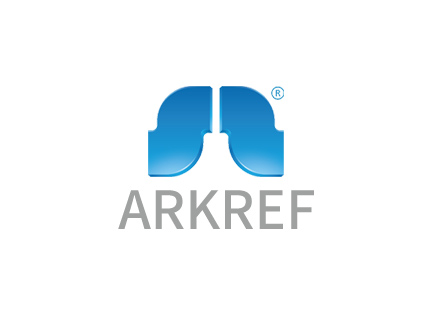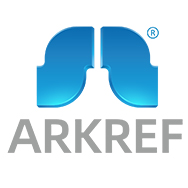Understanding Water Chillers and Their Main Applications
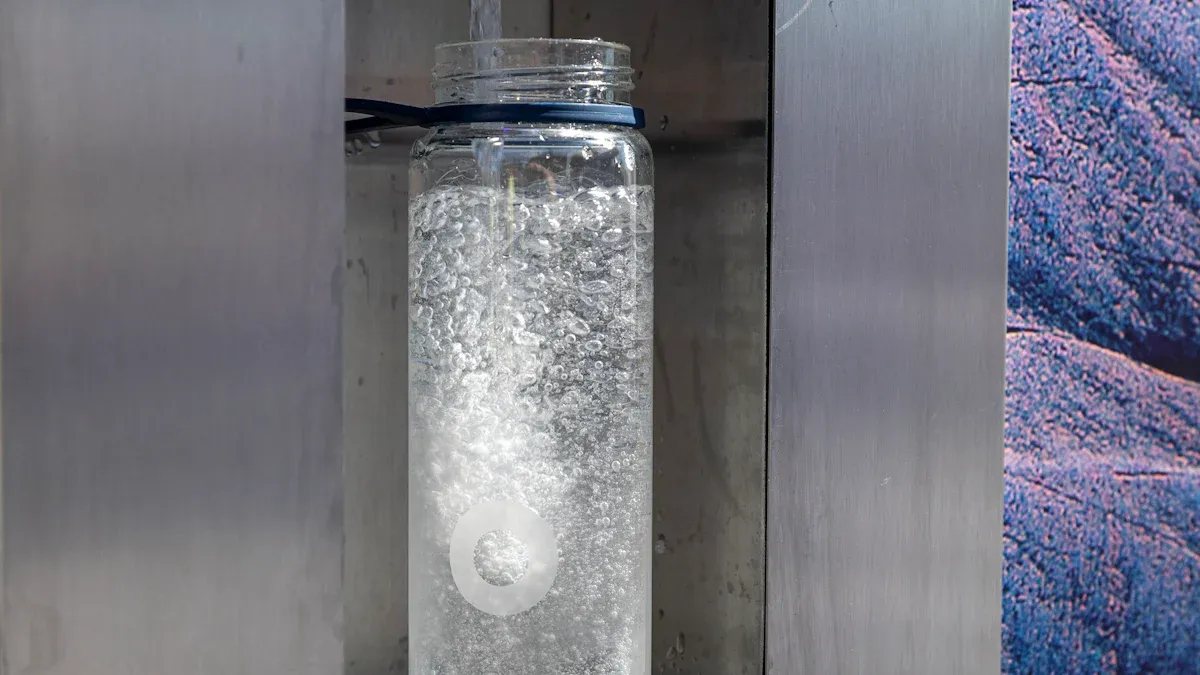
A water chiller makes water cold to a certain temperature. This helps you control heat in different places. You use this machine when you need the same temperature all the time. Machines, buildings, and medical devices need steady temperatures. Water chillers stop things from getting too hot. They help everything work well. Many factories, offices, and hospitals use water chillers. These places need them to work safely and easily.
Key Takeaways
Water chillers make water cold. They help keep machines, buildings, and medical devices at the right temperature. This stops them from getting too hot. It also helps everything work well.
Modern water chillers use less energy and water. They warn you early if there is a problem. They can grow with your needs. This helps you save money and keeps your equipment safe.
Water chillers use a refrigeration cycle. They have important parts like compressors, evaporators, and condensers. These parts take away heat very well.
There are different types of chillers for different jobs. Air-cooled chillers are good for small jobs. Water-cooled chillers work for big spaces. Glycol chillers are for very cold temperatures. Inverter chillers help save energy.
Picking the right chiller means you need to match cooling power, energy use, space, and control needs. Regular care and expert training help chillers work their best.
What Is a Water Chiller

Basic Function
A water chiller cools water to a set temperature. You use it when you need to keep things from getting too hot. The machine takes heat out of the water and sends the cooled water where you need it. You can find water chillers in factories, hospitals, and large buildings. They help keep machines, rooms, or medical tools at the right temperature.
You control the temperature with great accuracy. Some water chillers can keep water within a fraction of a degree of your target. This level of control is important for making sure products, machines, or people stay safe and work well.
Tip: You can use a water chiller in both small and large setups. Some models let you add more units if your needs grow.
Key Benefits
When you use a water chiller, you get many advantages. Here are some of the main benefits:
You save energy because modern chillers use efficient compressors and pumps.
You spend less on water. Closed-loop systems recycle water instead of wasting it.
You get early warnings if something goes wrong. Built-in diagnostics and alarms help you fix problems fast.
You can expand your system without replacing the whole thing.
You protect your equipment. Corrosion-resistant parts last longer, even in tough places.
You keep temperatures steady, which is vital for making products or running tests.
You lower your costs over time. Less water and energy use means you save money.
You can choose mobile or permanent setups. Some chillers offer remote monitoring and automatic controls.
Here is a table showing how water chillers perform under different conditions:
Heat Power (kW) | Valve Opening (%) | Fan Speed (%) |
|---|---|---|
95.0, 70.0, 45.0, 20.0, 45.0, 70.0, 95.0 | 100.0, 55.0, 30.0, 100.0, 30.0, 55.0, 100.0 |
Sensors measure the temperature at different points. The system checks how much heat the water chiller removes. This helps you see how well the chiller works and how much energy it uses.
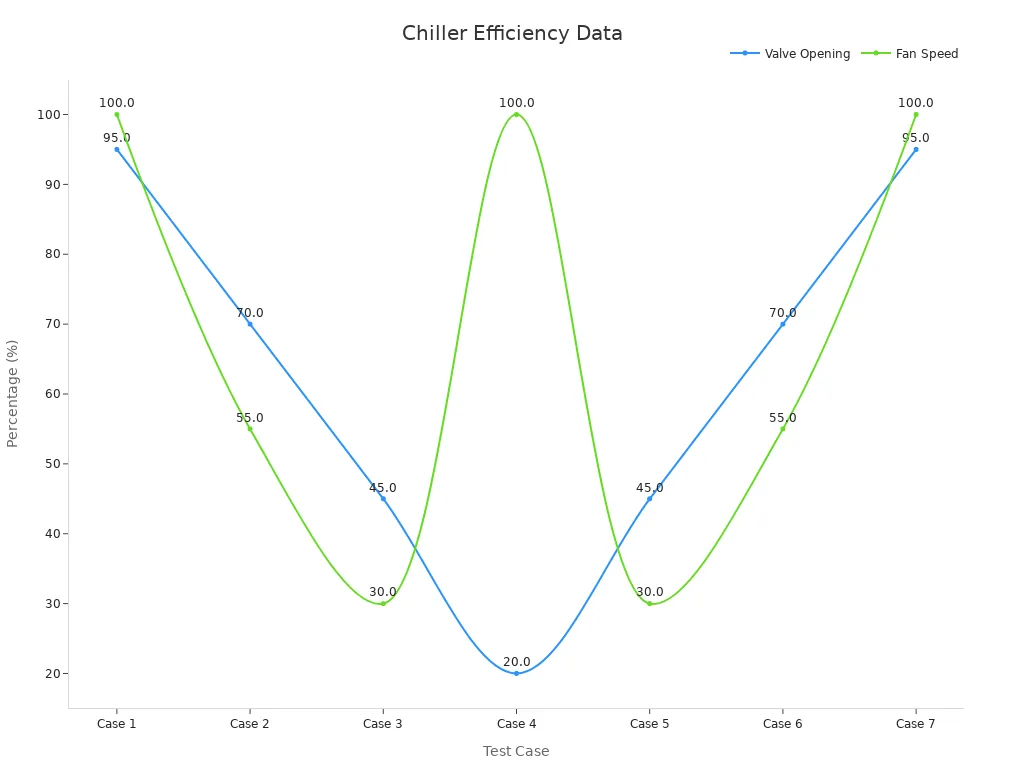
You also help the environment when you pick an energy-efficient water chiller. Many new models use eco-friendly refrigerants and smart controls. These features lower greenhouse gas emissions and let you monitor the system from anywhere. You can even set up automatic maintenance reminders.
Note: Water-cooled chillers now make up more than half of the industrial market. They offer better energy savings and handle bigger jobs than air-cooled models.
How Water Chillers Work
Refrigeration Cycle
You can learn about a water chiller by looking at its refrigeration cycle. This cycle has four main steps. These steps are compression, condensation, expansion, and evaporation. Each step helps move heat out of the water. This keeps things cool.
Compression: The compressor squeezes the refrigerant gas. This makes the gas hotter and increases its pressure.
Condensation: The hot gas goes to the condenser. Here, it cools down and turns into a liquid. The condenser lets heat out into the air or water outside.
Expansion: The liquid refrigerant goes through an expansion valve. The pressure drops, and the liquid gets much colder.
Evaporation: The cold refrigerant goes into the evaporator. It takes heat from the water and turns back into a gas. This cools the water that moves through the chiller.
The refrigeration system repeats these steps again and again. This gives you steady and reliable cooling.
Main Components
A water chiller uses several important parts to keep water at the right temperature. Each part has a special job to do:
Compressor: This is the main part of the chiller. It moves the refrigerant and controls the pressure.
Evaporator: The refrigerant takes heat from the water here. The water gets cold as it passes through.
Condenser: This part lets out the heat taken from the water. It uses air or water to carry the heat away.
Expansion Valve: This valve controls how much refrigerant goes into the evaporator. It helps keep the cooling steady.
Cooling Tower (for some systems): This tower helps get rid of extra heat from the condenser. It is used in big buildings.
You can see how these parts work together by looking at their performance. For example, the compressor can get more efficient (COP) from about 31 to over 53. This depends on the design. The evaporator can cool water to very low temperatures. Sometimes it can go down to -35°C or even lower. The condenser works best when the temperature difference over the outside air (CTOA) is between 15° and 30°. This depends on the system’s energy rating.
Component | Metric/Parameter | Typical Values / Range |
|---|---|---|
Compressor | COP Improvement | 31.32, 39.82, 53.22 |
Evaporator | Evaporator Temperature | -10°C, -25°C, -30°C, -35°C, -102°C |
Condenser | Condensing Temp. Over Ambient | |
Evaporator | Superheat Range | 5° to 15° (typical TXV system) |
Condenser | Subcooling Range | 8° to 14° (typical TXV system) |
Note: The way the cooling tower is built can change how well your chiller works. Some towers use special fill materials to help move heat better and save energy.
Heat Transfer
The main job of a water chiller is to take heat out of water. You can measure how much heat the chiller removes with a simple formula:
Q = m × c × ΔT
Q is the heat removed (in joules or kilowatts).
m is the mass flow rate of the water.
c is the specific heat of water (4182 J/kg°C).
ΔT is the temperature difference between the water going in and out.
Sensors check the temperature at the inlet and outlet. A flow meter checks how much water moves through the system. You can change the valve opening and fan speed to control how much heat the chiller removes. If you open the valve more, more water flows, and the chiller can take out more heat. The fan helps move heat away from the condenser, making the process faster.
In real tests, water chillers can handle heat loads from 1.0 kW up to 32.0 kW. You can see how the system works by watching the valve opening and fan speed. These controls help you keep the water at the right temperature, even if the heat load changes.
Tip: You get the best results when you pick the right size chiller for your needs. If it is too small, it cannot keep up. If it is too big, you waste energy.
Water Chiller Applications
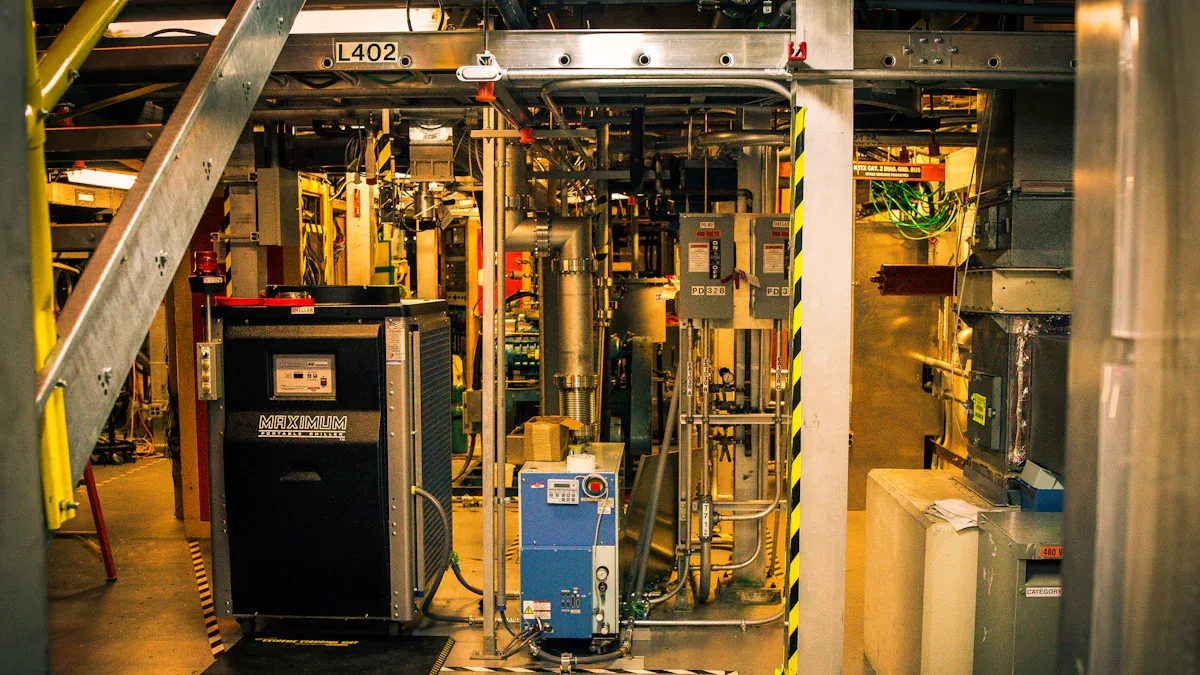
Industrial Uses
Factories and plants use water chillers a lot. These machines keep equipment cool for many hours. In manufacturing, a water chiller takes heat away from machines and molds. It also cools chemical processes. This helps everything work well and stops overheating. You can find water chillers in plastics and food factories. They are also used in beverage and chemical plants. Metalworking and printing companies use them for cooling too. Keeping water at the same temperature is very important. If the temperature changes, products can have problems or get wasted.
Did you know? The industrial air chiller market will grow over 5.8% each year from 2026 to 2033. This is because factories, HVAC, and healthcare need better cooling.
Commercial and HVAC
Large buildings and offices often use chilled water systems. Shopping centers use them too. These systems help keep rooms comfortable and safe. A chiller cools water and sends it through pipes. The water goes to air handlers or fan coils. This keeps every room cool. Hotels, schools, and data centers use water chillers for steady cooling. In North America, more buildings mean more chillers are needed. Europe and Asia-Pacific also need more chillers because of new energy rules and city growth.
Industry/Application | Statistic/Insight | Supporting Detail |
|---|---|---|
Manufacturing & HVAC | Growth driven by manufacturing, HVAC, and healthcare sectors | |
Baths and Chillers Market | Projected CAGR 13.7% by 2032 | Industrial applications have greatest impact due to thermal management in manufacturing and production |
Medical Applications | Cincinnati Sub-Zero (CSZ) specializes in temperature management systems | Supports medical and scientific research requiring precise cooling |
Medical and Specialty
Hospitals and labs use water chillers for cooling. Research centers need them too. Medical devices and MRI machines must stay cool to work right. Lasers also need steady cooling. Even small temperature changes can hurt test results or patient care. Some chillers keep aquariums and ice baths at the right temperature. Companies like Cincinnati Sub-Zero make special chillers for science and medicine. The chiller control panel market is growing fast. This is because healthcare and research need very good cooling.
Tip: Always pick a water chiller that fits your needs. Good temperature control keeps things safe and high quality in every use.
Water Chiller Types
There are different types of water chillers you can pick. Each type is best for certain jobs and places. Knowing the differences helps you choose the right one for your needs.
Air-Cooled vs. Water-Cooled
Air-cooled chillers use fans to blow air on coils. This cools the water by moving heat away. You often see these chillers outside on rooftops or next to buildings. They work well if you have enough space and good airflow. You do not need extra water, so you save money. These chillers are simple to set up and easy to take care of.
Water-cooled chillers use water from a cooling tower to remove heat. These are found in big buildings or factories. They can cool large areas and work better when it is hot outside. Water-cooled chillers use less energy than air-cooled ones for big jobs. You need a steady water supply and more room for the equipment.
Tip: Air-cooled chillers are good for small or medium jobs. Water-cooled chillers are better for big spaces and high cooling needs.
Glycol Chillers
Glycol chillers use water mixed with glycol. Glycol keeps the water from freezing. These chillers are used for very cold temperatures. Breweries, food factories, and ice rinks often need them. Glycol chillers keep the temperature steady, even when it is very cold. They give safe and steady cooling for special uses.
Inverter Chillers
Inverter chillers use smart controls to change the compressor speed. This gives you just the right amount of cooling. You save energy and keep the temperature steady. Inverter chillers are great when your cooling needs change during the day.
Here is a table that compares inverter chillers and on-off chillers:
Performance Metric | Inverter Chillers | On-Off Chillers |
|---|---|---|
Power Consumption Reduction | Baseline (100%) | |
Temperature Regulation Precision | ±0.1°C | ±1°C |
Response to Thermal Load Changes | Immediate | Delayed |
Cooling Capacity Modulation | Yes, adjusts dynamically | No, fixed capacity |
Reliability Across Range | High | Standard |
You can see inverter chillers use less power and keep water at a more exact temperature. They react quickly to changes in heat. This makes them a smart choice for saving energy and keeping things cool.
When you pick a water chiller, think about your space, how much cooling you need, and your budget. Each type has special benefits for different jobs.
Choosing a Water Chiller
Key Factors
When you pick a water chiller, you should think about a few main things. Each thing helps you find the right chiller for your needs. Here are some things to look at:
Cooling Capacity: Make sure the chiller can cool your space enough. You can use the formula
Q = m × c × ΔTto figure out what you need.Energy Efficiency: Try to find chillers that move heat well and use less energy. If the heat transfer is high, cooling is better. If the pressure drop is low, you save energy.
Space and Location: Check if you have enough space for the chiller. Air-cooled chillers need good air flow. Water-cooled chillers need more room for cooling towers.
Temperature Control: Pick a chiller that keeps water at the right temperature. Some chillers can keep the temperature within ±0.1°C.
System Flexibility: Choose a system that lets you add more chillers if you need them later.
Reliability: Use chillers with alarms and checks built in. These help you find problems early.
You can also use special ways to compare chillers. For example, you can use normalization to check heat transfer and pressure drop. You can use Grey Relation Coefficients (GRC) and Grey Relation Grades (GRG) to rank chillers. Signal-to-Noise Ratio (SNR) helps you find the best settings. Analysis of Variance (ANOVA) shows which parts matter most. These tools help you pick the best chiller for your job.
Professional Tips
Experts say you should follow good steps when you pick and take care of a water chiller. Here are some tips to help you:
Join learning programs, like ones from Vertiv, to learn about new chillers. These programs have webinars and classes from experts.
Always match the chiller to your space. For example, data centers need chillers that can handle lots of heat.
Use certified training to keep your skills sharp. Some classes let you earn Continuing Education Units (CEUs).
Do not use a chiller the wrong way. This can make it break sooner and waste energy.
Keep up with maintenance. Checking your chiller often helps it last longer and work better.
Tip: Learning from experts and keeping up with training helps you make smart choices and get the most from your water chiller.
You now know how cooling systems work and where you can use them. You saw why picking the right type matters for your space and needs. If you face a big or tricky job, talk to a professional for help. When you understand these systems, you make better choices and keep your equipment safe and cool.
FAQ
What size water chiller do you need?
You should match the chiller size to your cooling needs. Check the heat load in kilowatts or BTUs. Use the formula Q = m × c × ΔT to help you decide. Ask a professional if you feel unsure.
How often should you maintain a water chiller?
You should check your chiller every month. Clean filters and inspect for leaks. Schedule a full service once a year. Regular care helps your chiller last longer and work better.
Can you use a water chiller outdoors?
Yes, you can use air-cooled chillers outdoors. Place them where air flows well. Protect the unit from rain and snow. Water-cooled chillers usually stay inside because they need extra equipment.
What happens if your chiller is too small?
A small chiller cannot keep up with cooling. Your equipment may overheat. You might see higher energy bills and more breakdowns. Always choose a chiller that matches your needs.
Are water chillers energy efficient?
Many modern water chillers use less energy. Look for models with inverter technology or eco-friendly refrigerants. These features help you save money and protect the environment.
See Also
A Comprehensive Guide To How Water Chiller Units Work
Choosing The Right Industrial Water Chiller Units Easily
Proven Strategies To Boost Efficiency In Walk-In Chillers
Maximizing Chiller And Compressor Output In ARKREF CO₂ Systems
Top Three Uses For ARKREF CO₂ Transcritical Refrigeration Units
